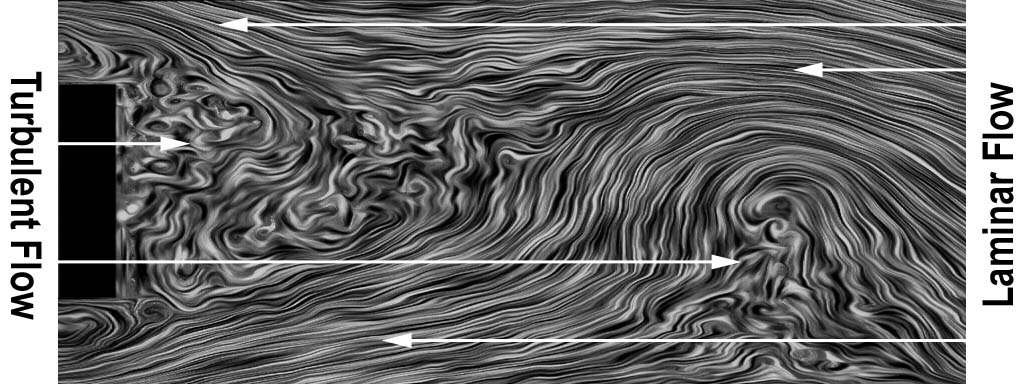Definition
The air flow coefficient is a property of an aperture, fan, vent or duct that measures the efficiency with which air can flow through it. It is directly related to the size of an opening and its value is proportional to the volumetric air flow rate through the opening and inversely proportional to the pressure difference across it. The nature of any obstructions or direction changes in the air flow path is also very important as this determines the amount of turbulent flow compared to laminar flow.

Figure 1: An example showing areas of laminar and turbulent flows as low-mid velocity air moves around an obstruction.
Units
The term flow coefficient is a bit of a catch-all that covers a range of different types of coefficients. For example, a volumetric air flow coefficient (Cv ) used for calculating the air flow rate through cracks and gaps is given as a value in cubic metres per second per 1 Pascal pressure difference (m³/sPa). On the other hand, discharge coefficients (Cd ) and pressure coefficients (Cp ) are given as dimensionless ratios between some actual and theoretical flow rate, with values between 0 and 1 where perfect unimpeded flow would be 1 and completely obstructed flow would be 0.
Calculating Flow Rates
The volumetric air flow coefficient is used in equations such as the following, in this case for air flow through an irregular gap or crack.
where:
- Q is the volume flow rate, (m³/h)
- Cv is the volumetric air flow coefficient (m³/sPa),
- Δp is the pressure difference acting across the opening (Pa), and
- n is the flow exponent indicating the degree of turbulence (0-1).
An n value of 0.5 represents fully turbulent flow and 1.0 represents fully laminar flow. The typical n value for a whole buildings is 0.66 [ref].
For turbulent flow through a regular rectangular window or vent, usually represented as a flat plate orifice, a different volume flow rate equation is used, as shown below.
where:
- Q is the volume flow rate, (m³/h)
- Cd is the discharge coefficient (0-1), and
- A is the volume flow rate, (m2)
- Δp is the pressure difference acting across the aperture (Pa), and
- δ is the air density (kg/m³).
In the absence of detailed information, the discharge coefficient (Cd ) is usually given a value of 0.61. Air flow through an orifice is assumed to be turbulent, thus the flow exponent n is given the value 0.5.
To make overall calculations much easier, it is possible to to express both of these equations in the same form. For more details on this, see the Veetech tutorials.
Useful References
Click here to comment on this page.